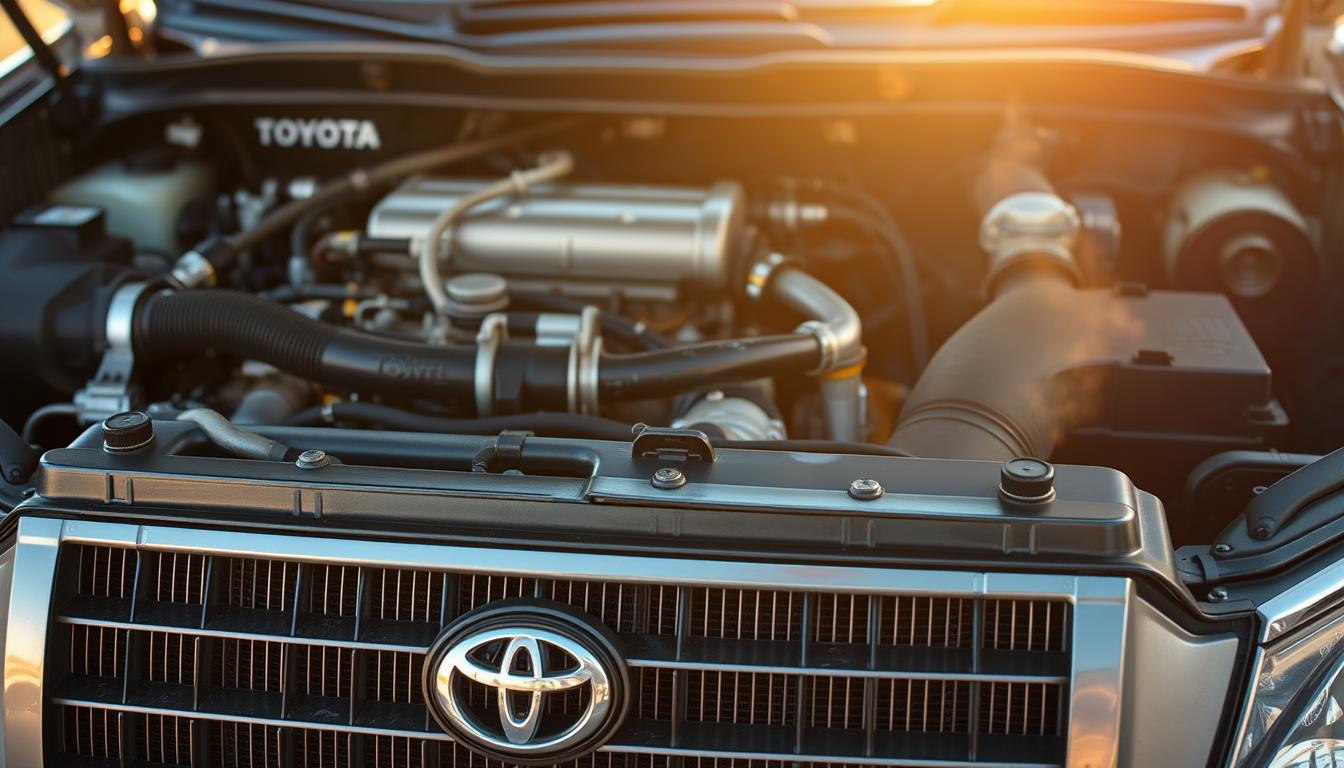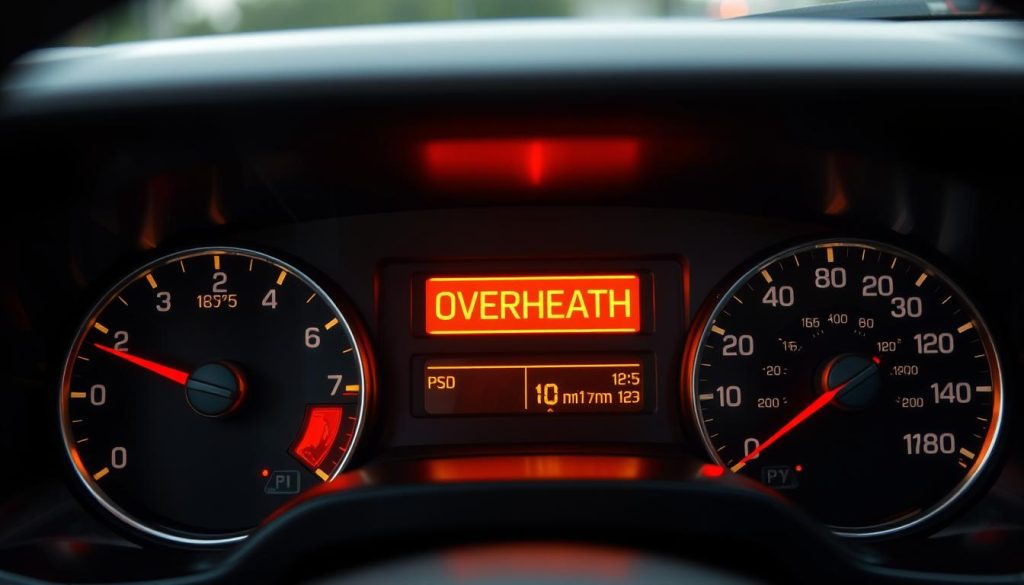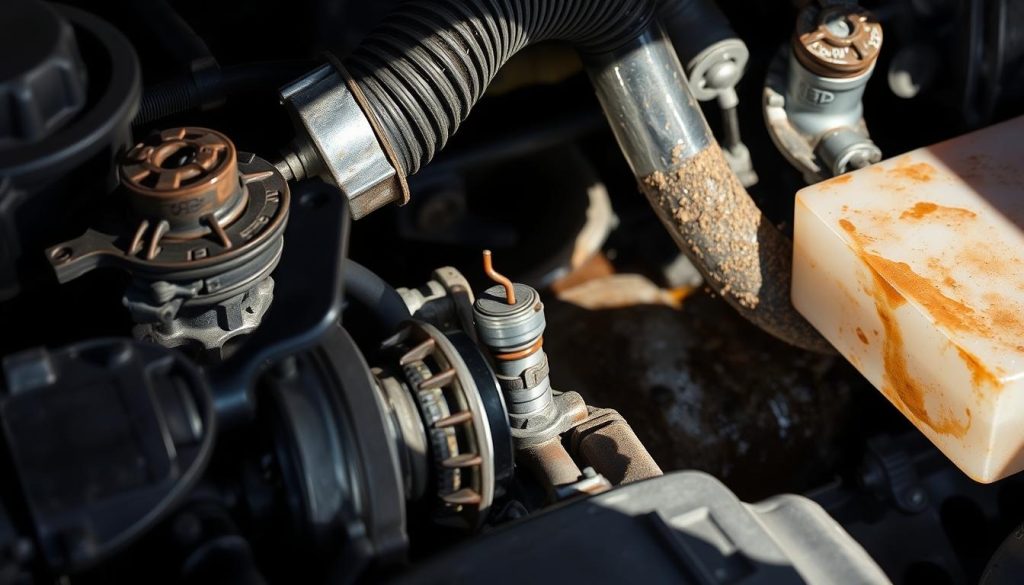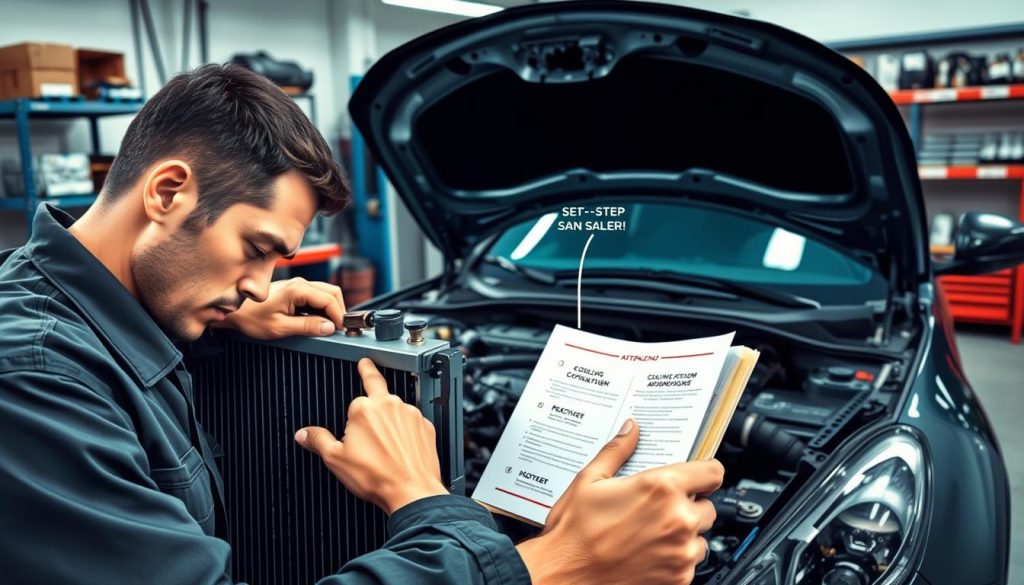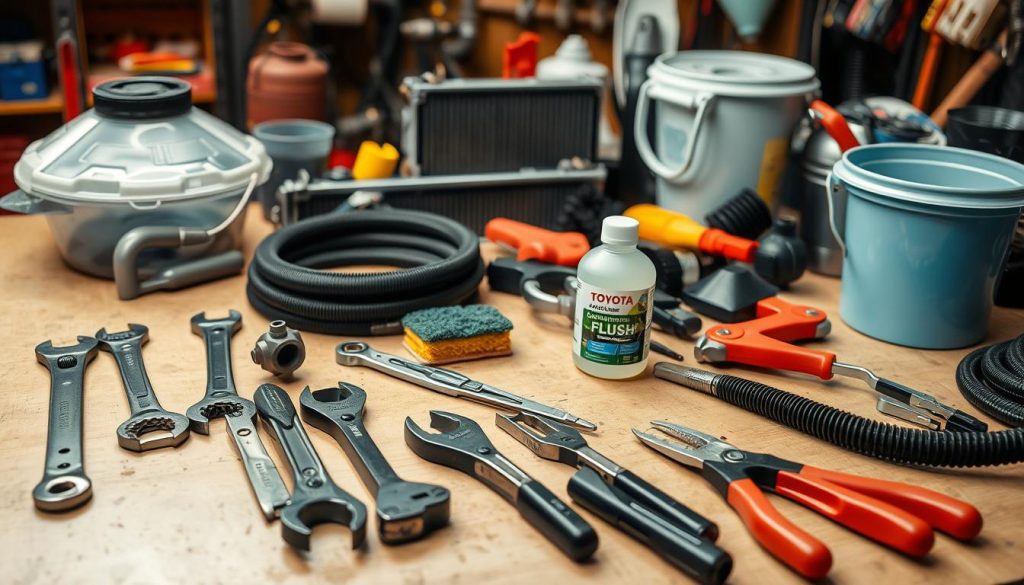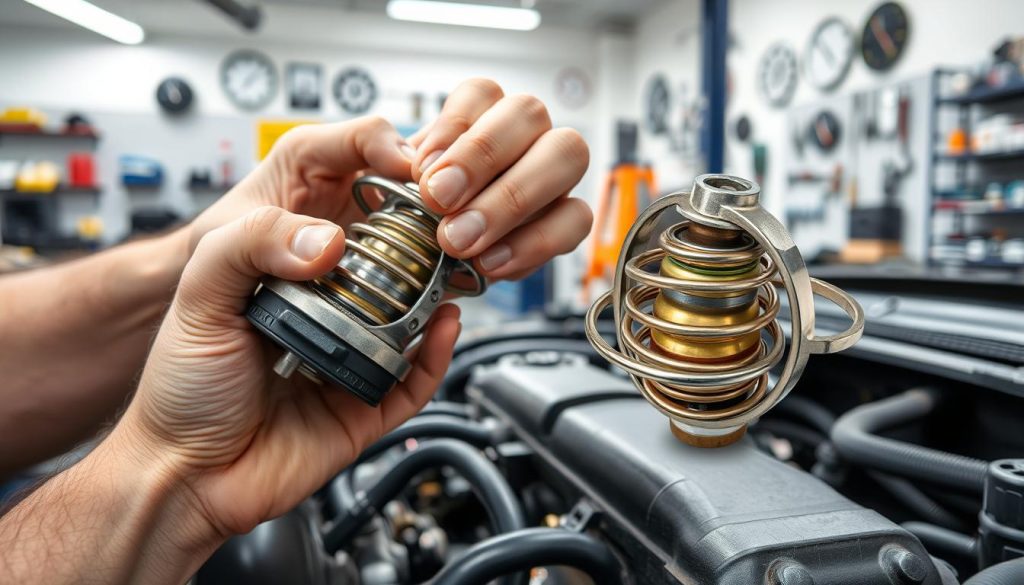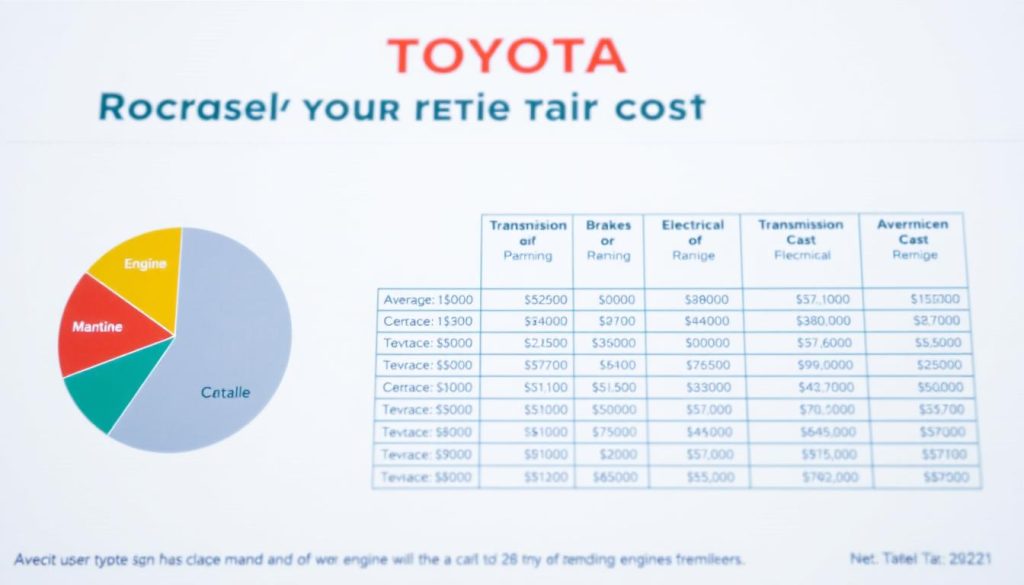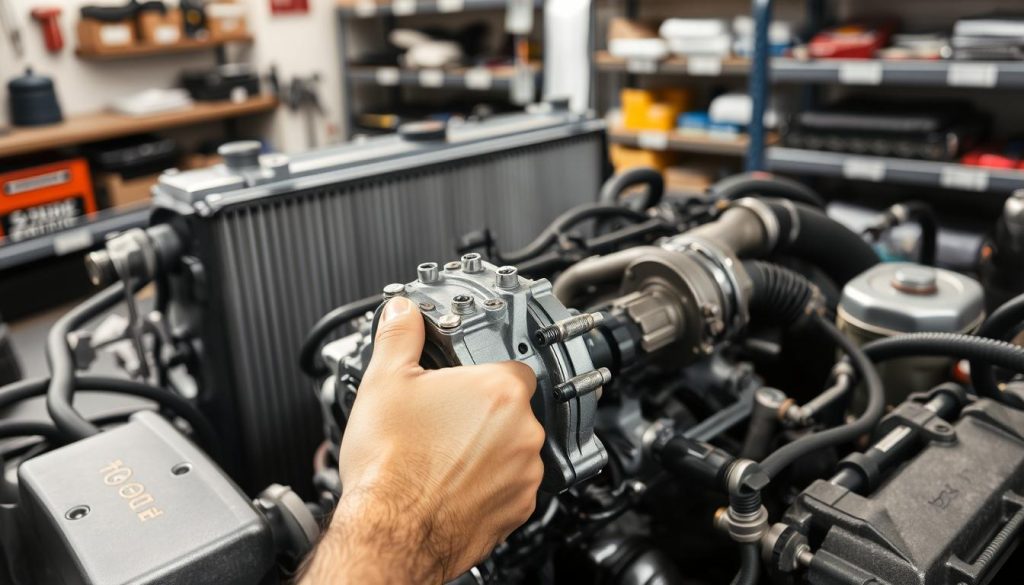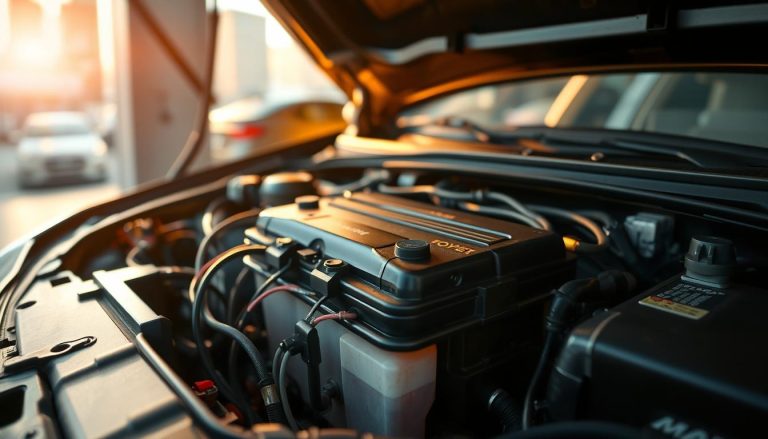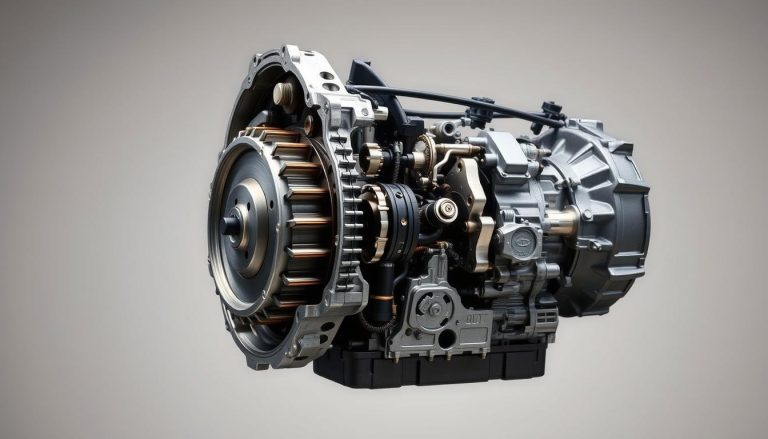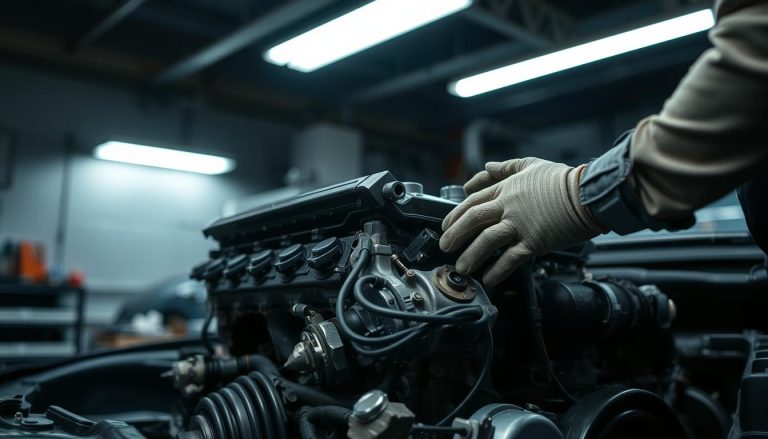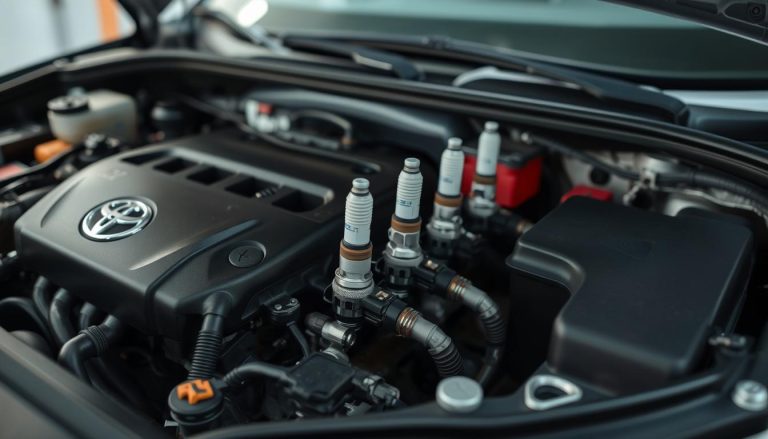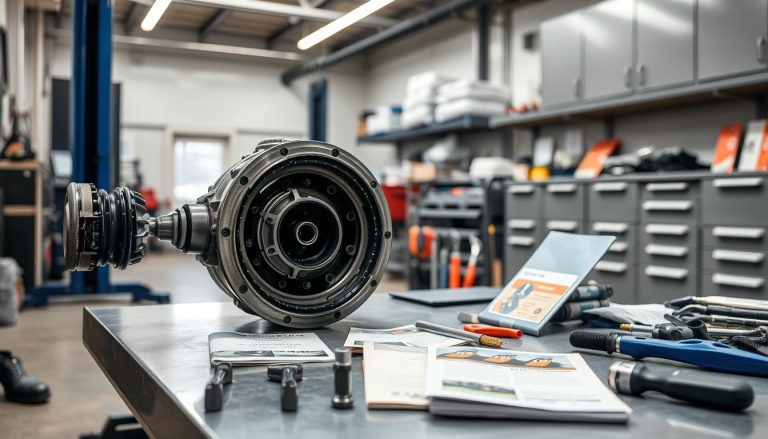Toyota Engine Overheating: Causes, Symptoms, and Fixes
When your car’s temperature gauge goes into the red, it’s a serious problem. Engine overheating can ruin your motor in minutes. The cooling system keeps your car at safe temperatures all the time.
Many drivers face costly breakdowns yearly because they missed early signs. Problems like cracked cylinder heads and blown gaskets can happen if you ignore these signs.
This guide will help you prevent and handle overheating issues. You’ll learn how to spot problems early and what to do if your Toyota overheats. We’ll cover proven solutions and maintenance tips to avoid expensive repairs.
Key Takeaways
- Recognize early warning signs like rising temperature gauges and steam from the hood
- Understand common causes including low coolant, faulty thermostats, and radiator blockages
- Learn immediate safety steps when your vehicle starts running too hot
- Discover preventive maintenance tips to avoid costly repairs
- Know when to seek professional help versus DIY solutions
- Identify long-term strategies for keeping your cooling system healthy
Understanding Engine Overheating in Toyota Vehicles
Knowing how your Toyota’s cooling system handles high temperatures is key. It keeps your engine running smoothly and safely. If it fails, you could face engine damage or even replacement.
Your Toyota’s cooling system has many parts working together. The radiator, water pump, and thermostat help keep the engine cool. They remove heat from the engine and keep it safe.
What Happens When Your Toyota Engine Overheats
When the Toyota cooling system fails, your engine gets too hot. This heat can damage the engine’s metal parts. It can cause pistons to seize and gaskets to fail.
The first sign of trouble is the engine temperature gauge going into the red zone. At this point, damage may already be happening. Running the engine further can cause more harm, like blown head gaskets or a cracked engine block.
Even though Toyota engines are made to handle heat, they have limits. Prolonged overheating can cause permanent damage. This might need expensive repairs or a new engine.
Normal vs. Dangerous Operating Temperatures
Your Toyota engine works best between 195°F and 220°F (90°C to 104°C). This keeps it running efficiently and protects it from damage.
Running cooler than this can make your engine less efficient. It might use more fuel and produce more emissions. But it’s not usually harmful.
But, if your engine gets too hot, over 230°F (110°C), you need to act fast. Immediate action is required to avoid serious damage. Temperatures over 250°F (121°C) can cause damage in just minutes.
Recognizing the Warning Signs of Overheating
Understanding what your Toyota is trying to tell you is key. It has warning systems to alert you before damage happens. Recognizing engine overheating symptoms early can save you from expensive repairs.
Many drivers ignore early warning signs, leading to costly repairs. Knowing what to look for can prevent major engine issues. Your Toyota sends clear signals when it’s too hot.
Dashboard Temperature Gauge Readings
Your dashboard is like the control center for your engine. The temperature gauge needle should stay in the middle. If it moves towards the red, you have minutes to act.
The temperature warning light looks like a small thermometer on your dashboard. It lights up when the coolant gets too hot. Some Toyotas show the exact temperature on digital displays.
Don’t wait until the needle hits the red. Act when it goes beyond normal. Modern Toyotas may also show messages like “Engine Hot” or “Coolant Temp High” on the display.
Steam and Smoke Indicators
Steam from engine compartments is a clear warning sign. White vapor from under the hood means the coolant is boiling. This steam smells sweet from the antifreeze.
Smoke can mean different things. White steam is usually coolant issues, while blue smoke means oil is burning. Black smoke suggests fuel system problems that can cause overheating.
Never ignore steam or smoke, even if it’s brief. These signs mean your cooling system is too hot. Pull over safely if you see vapor from the engine bay.
Unusual Sounds and Smells
Your ears and nose can also warn you of overheating. Knocking or pinging sounds from the engine mean metal parts are expanding too much. These sounds often happen when it’s getting hotter.
A sweet, syrupy smell from the vents means coolant is leaking onto hot parts. This smell gets stronger as temperatures rise. An acrid burning smell can also mean overheating engine parts.
Listen for strange sounds like grinding, squealing, or rattling from the engine bay. These sounds often mean failing water pumps or loose belts. Addressing these engine overheating symptoms immediately can prevent big repairs.
Immediate Emergency Steps When Overheating Occurs
When your car overheats, quick action is key. Emergency engine cooling needs calm and fast steps to keep your car and passengers safe. Every second is important when your Toyota’s temperature gauge goes up.
Your fast response can save thousands of dollars in repairs. Never ignore the warning signs or try to keep driving. Driving an overheating engine can lead to major damage.
Safe Pulling Over Procedures
When your car overheats, find a safe spot to stop right away. Turn on your hazard lights to warn other drivers. These safe pullover procedures help protect your engine.
Drive carefully to the side of the road or a parking lot. Avoid sudden moves to prevent accidents. Try to stop in a place away from a lot of traffic.
Turn off your air conditioning right away. Instead, turn your heater to the highest setting and fan speed. This helps cool the engine before you stop.
Engine Shutdown Protocol
Once stopped safely, turn off the engine quickly. This step is vital to avoid more damage. Leave the ignition on to keep the cooling fans running if your Toyota has electric fans.
Put the car in park and use the parking brake. Turn off all accessories except hazard lights. These overheating first aid steps help cool the engine.
Don’t open the hood right away. The cooling system is under high pressure and temperature. Opening it too soon can cause serious burns from steam or hot coolant.
Safety Precautions to Follow
Get everyone out of the car and to a safe place. Stay away from traffic and use barriers if you can. Safety is the top priority in emergencies.
Wait at least 30 minutes before checking the engine. This lets the system cool down and temperatures drop. Pressurized coolant can get over 250°F.
Never remove the radiator cap while the engine is hot. Even after waiting, use a thick cloth or towel to protect your hands. Turn the cap slowly to release any remaining pressure gradually.
Keep a safe distance from the front of the car. Steam and hot coolant can spray out unexpectedly. Your patience during this time protects your engine and your safety.
Toyota Engine Overheating Root Causes
Many parts in your Toyota’s cooling system can fail, leading to engine overheating. Each part has a role in keeping your engine cool. If one fails, the whole system can’t do its job.
Knowing these causes helps you catch problems early. This can save you a lot of money on repairs. Most Toyota cooling system failure issues fall into three main categories that we’ll explore below.
Cooling System Component Failures
Your Toyota’s cooling system has many parts that must work together. The radiator cools the coolant as air flows through its fins. Cooling fans help when your car isn’t moving fast enough.
Hoses carry pressurized coolant through the system. These can crack or leak over time. Temperature sensors monitor the system and tell your engine’s computer when to turn on the fans or adjust other settings.
If any of these parts fail, your engine temperature rises quickly. A cracked hose can drain coolant fast. A broken cooling fan won’t provide enough airflow in traffic or hot weather.
Thermostat Malfunctions
Thermostat problems are common causes of engine overheating. Your thermostat acts like a valve that opens and closes based on engine temperature. It stays closed when the engine is cold to help it warm up faster.
Once your engine reaches normal operating temperature, the thermostat opens to allow coolant circulation. A stuck-closed thermostat prevents coolant from flowing through the radiator. This causes rapid overheating because hot coolant can’t release its heat.
A thermostat that sticks open creates different problems. Your engine runs too cool, which reduces fuel efficiency and increases emissions. Both scenarios require immediate thermostat replacement to restore proper cooling system function.
Water Pump Breakdowns
The water pump is your cooling system’s heart by circulating coolant throughout the engine. Water pump failure stops this circulation completely, leading to severe overheating within minutes of driving.
Most water pumps fail gradually. You might notice coolant leaks under your car or hear grinding noises from the engine bay. Worn bearings inside the pump create these sounds as metal parts rub against each other.
A damaged impeller inside the pump can’t move coolant effectively. This reduces circulation even if the pump runs. Regular maintenance helps identify water pump problems before they cause complete cooling system failure.
| Component | Common Failure Signs | Repair Urgency | Estimated Cost Range |
|---|---|---|---|
| Thermostat | Overheating, poor heater performance | High | $150-$300 |
| Water Pump | Coolant leaks, grinding noise | Critical | $400-$800 |
| Radiator | External leaks, poor cooling | High | $300-$600 |
| Cooling Fans | Overheating in traffic, no fan noise | Medium | $200-$450 |
Coolant System Problems and Solutions
Coolant system issues are a major cause of Toyota engine overheating. Coolant does more than prevent freezing. It also transfers heat, lubricates seals, and protects metal from corrosion. Neglecting coolant maintenance can lead to expensive engine damage.
Your Toyota’s cooling system needs the right conditions to work. Proper coolant levels and clean fluid circulation are essential to avoid overheating. Knowing common coolant problems helps you fix issues early and save money.
Low Coolant Level Issues
Low coolant levels are a big risk for your Toyota’s engine. Without enough coolant, the engine can’t cool down properly. This can cause damage to cylinder heads or engine blocks.
Several things can lower coolant levels. Normal evaporation is one reason, and older vehicles lose more. Small leaks often go unnoticed until it’s too late. Regular checks can prevent major repairs.
Check your coolant reservoir when the engine is cold. The fluid should be between the minimum and maximum marks. If levels keep dropping, you have a leak that needs fixing.
Identifying and Fixing Coolant Leaks
Finding coolant leaks starts with knowing where to look. Look for bright green, orange, or pink puddles under your car. Sweet-smelling fluid stains on your garage floor also indicate a problem.
Internal leaks are harder to spot. White exhaust smoke when the engine is warm means coolant is burning. If your oil looks milky or foamy, it’s mixed with coolant.
Common leak spots include:
- Radiator hose connections and clamps
- Water pump housing and gasket surfaces
- Radiator core and end tank seams
- Thermostat housing gaskets
- Heater core connections inside the cabin
Dealing with Contaminated Coolant
Contaminated coolant hurts your cooling system’s performance. Rust, oil, and debris block passages in the radiator and engine block. This stops heat transfer and causes overheating.
Signs of dirty coolant include rusty or muddy color, floating particles, and oily residue. Clean coolant should be bright and flow freely without debris.
To fix contaminated coolant, flush the system completely. This removes old fluid, clears passages, and adds fresh coolant. Professional equipment ensures a thorough clean.
Regular maintenance prevents overheating issues. Flush your coolant system as recommended by your Toyota’s schedule. This is usually every 30,000 to 60,000 miles, depending on your model and coolant type.
Radiator-Related Overheating Causes
Your Toyota’s radiator is key to keeping the engine cool. When radiator problems happen, the engine can overheat. The radiator’s design helps it cool down, but it can get damaged or clogged.
Knowing about common radiator issues helps avoid engine damage. Most overheating problems come from blockages, fin damage, or cap issues.
Core Blockage Issues
A clogged radiator is a common cause of overheating. Dirt, leaves, and insects can block airflow. This makes the radiator less effective at cooling.
Inside the radiator, rust and old coolant can also block the tubes. Stop-leak additives can make this problem worse over time.
You might see the engine temperature gauge go up during traffic or hot weather. Steam under the hood is another sign. Cleaning the radiator regularly and flushing the coolant system can help.
Fin Damage Complications
Damaged radiator fins can also cause cooling problems. Debris, hail, or accidents can bend or break these fins. Salt can also corrode them.
Bent fins can block airflow, leading to overheating. Missing or severely damaged fins reduce the radiator’s ability to cool. This is a big problem on long drives.
Minor fin damage can be fixed with a fin comb tool. But, serious damage needs a professional. Regular checks can catch problems early.
Pressure Cap Failures
Radiator cap replacement is important but often forgotten. The cap keeps the system pressure right, which helps the coolant circulate properly. Most Toyotas need a pressure between 13-16 PSI.
A bad cap can let coolant leak out. Weak spring pressure in an old cap can also cause problems. A cap that won’t release pressure can damage hoses or the radiator.
Look out for signs like coolant loss without leaks, white residue, or overheating that comes and goes. Replacing the cap every 2-3 years can prevent big problems. It’s a small fix that keeps the cooling system working well.
Step-by-Step Diagnostic Process
Effective cooling system diagnosis starts with knowing what to look for and how to test each part. A systematic approach is key to successful diagnosis. It keeps you safe and helps find the problem. Being patient can save you a lot of money in repairs.
Before you start engine overheating troubleshooting, let your Toyota cool down for 30 minutes. Hot coolant can cause burns, and touching hot engine parts can hurt you. Never check fluid levels or remove the radiator cap when the engine is warm.
“A thorough diagnostic approach prevents misdiagnosis and ensures you’re fixing the actual problem, not just the symptoms.”
Visual Inspection Checklist
Begin by visually checking the cooling system. Look for coolant puddles or wet spots under your Toyota. Coolant is usually green, orange, or pink, depending on your car.
Check hoses for cracks, bulges, or soft spots. Look at the radiator fins for damage or debris. Also, check drive belts for proper tension and wear during a coolant system inspection.
Fluid Level and Condition Assessment
After the engine cools, check the coolant levels in the radiator and overflow reservoir. Low levels often mean leaks or consumption issues. The coolant should be at the “full” mark when cold.
Look at the coolant’s condition closely. Healthy coolant is clear with its original color. Brown, rusty, or oily coolant means internal engine problems. White or milky coolant usually means a blown head gasket.
Component Testing Procedures
Test the radiator cap with a pressure tester if you have one. A faulty cap can cause overheating. The cap should hold pressure as specified on top.
Check the cooling fans by starting the engine and letting it warm up. The fans should turn on when the temperature gauge reaches normal. Listen for unusual noises from the water pump, which can indicate problems.
Finish your engine overheating troubleshooting by testing the thermostat. Feel the upper radiator hose as the engine warms up. The hose should get hot when the thermostat opens, around 195°F. If the hose stays cool while the engine overheats, the thermostat needs to be replaced.
DIY Repair Methods for Common Issues
Simple DIY repairs can fix many Toyota cooling system problems without a trip to the shop. Overheating often comes from simple maintenance that you can do at home. These tasks boost your confidence and save money.
Always make sure your engine is cool before starting repairs. Hot coolant and steam can burn you badly. Wait at least two hours after driving before opening the hood.
How to Add Coolant Safely
DIY coolant repair begins with adding fluid the right way. Never open the radiator cap when the engine is hot. This can spray scalding coolant everywhere.
Check your owner’s manual for the right coolant type. Toyota cars need specific coolants. Mixing different types can harm your cooling system. Use a 50/50 mix of coolant and distilled water for best protection.
Slowly remove the radiator cap in two stages. First, turn it counterclockwise until it stops. Then, push down and turn more to remove it fully. Fill the system slowly to avoid air pockets.
Cleaning Radiator External Debris
Regular radiator cleaning stops overheating from blocked airflow. Leaves, insects, and road debris build up on radiator fins. This buildup cuts cooling efficiency a lot.
Use a soft brush or compressed air to clean debris. Start from the engine side to avoid pushing dirt deeper. A low-pressure garden hose also works for tough dirt.
Check the radiator fins for damage while cleaning. Bent fins block airflow and reduce cooling. Straighten damaged fins with a fin comb or small screwdriver.
Radiator Cap Replacement Guide
A bad radiator cap leads to pressure loss and overheating. This cheap part is key to coolant system maintenance. Replace caps every few years or when you see coolant loss without leaks.
Tools and Materials Needed
Get these items ready before replacing the radiator cap:
- New radiator cap with correct pressure rating
- Clean rags or paper towels
- Flashlight for inspection
- Owner’s manual for specifications
Step-by-Step Replacement Process
Start with a cool engine for safety. Remove the old cap using the two-stage method. Clean the radiator neck with a damp rag.
Look for cracks or damage on the neck that could stop proper sealing. Check the rubber gaskets on your new cap before installing. Press the new cap down firmly and turn clockwise until it locks.
Test the cap by starting the engine and watching for leaks. The temperature gauge should stay normal during your test drive. These basic radiator cleaning and maintenance skills prevent expensive repairs and keep your Toyota running well.
Major Component Replacement Guidelines
When Toyota cooling parts fail, replacing them is often the best option. Replacing major cooling system parts needs a good diagnosis and careful planning. Knowing when to replace these parts helps avoid frequent breakdowns and costly engine damage.
These repairs need more time and skill than simple maintenance tasks. But, many Toyota owners can do these projects with the right tools and patience. Proper preparation and quality parts make the difference between success and frustration.
When to Replace Your Thermostat
Thermostat replacement is needed when temperature control fails. Your Toyota’s thermostat should open and close smoothly to keep the engine at the right temperature. Erratic temperature gauge readings often mean thermostat problems that need quick attention.
Several signs show when your Toyota’s thermostat fails. The engine might overheat at idle but run fine while driving. Or, it might take a long time to warm up on cold mornings.
To replace the thermostat, start by draining the cooling system. Remove the upper radiator hose and find the thermostat housing. Always install the new thermostat with proper orientation – the spring side faces toward the engine block.
Use a new gasket or O-ring to prevent leaks during installation. Slowly refill the cooling system and make sure to remove air pockets. Test drive your Toyota to check if the temperature is controlled properly before finishing the job.
Water Pump Replacement Indicators
Water pump failure is a serious overheating risk that needs quick action. The water pump circulates coolant through your Toyota’s engine and cooling system. If it fails, engine temperatures rise quickly, causing severe damage.
Common signs of water pump problems include coolant leaks from the pump housing. You might hear unusual grinding or squealing noises from the engine’s front. Overheating despite enough coolant also points to water pump failure.
Replacing the water pump requires removing several parts first. Drain the cooling system and take out the cooling fans and drive belts. Some Toyotas need timing component removal for pump access.
Professional installation may be worth considering for water pump replacement. The job needs precise torque specifications and proper timing alignment. Mistakes can lead to expensive engine damage that’s more than the repair cost.
Complete Radiator Replacement Process
Radiator replacement is needed when the core is damaged beyond repair. Severe clogs, physical damage, or internal corrosion make replacement more cost-effective than fixing. A damaged radiator can’t keep coolant flowing or heat dissipated properly.
Signs needing radiator replacement include persistent overheating despite repairs. Visible damage to the radiator core or tanks also indicates replacement needs. Brown or rusty coolant suggests internal corrosion that cleaning can’t fix.
The radiator replacement process starts with draining the coolant completely. Disconnect all hoses, transmission cooler lines, and electrical connections. Remove the cooling fans and any brackets blocking radiator access.
Handle the new radiator carefully to avoid damage during installation. Connect all hoses and lines securely using new clamps where needed. Fill the system slowly and check for leaks before final testing.
| Component | Difficulty Level | Time Required | Special Tools Needed | Cost Range |
|---|---|---|---|---|
| Thermostat | Beginner | 1-2 hours | Basic hand tools | $15-$40 |
| Water Pump | Advanced | 4-6 hours | Timing tools, torque wrench | $80-$200 |
| Radiator | Intermediate | 2-4 hours | Hose clamp pliers, drain pan | $150-$400 |
| Complete System | Expert | 8-12 hours | Full tool set, lift access | $500-$1200 |
Success with major component replacement depends on honest assessment of your skills. These repairs save a lot of money if done right. But, mistakes can lead to expensive problems that cost more than professional repair.
Think about your available time and workspace before starting these projects. Quality parts and proper procedures ensure reliable results that last for years. When unsure, professional installation protects your investment and offers warranty coverage.
Professional Repair Options for Severe Damage
Severe overheating can damage Toyota engines beyond DIY fixes. When temperatures soar, many engine parts can be affected. Professional cooling system service is key to getting your car safe again.
Experts use special tools and facilities to diagnose and fix the damage. They find the best way to repair your car at a fair price. Plus, they offer warranties, so you can relax knowing your car is in good hands.
Blown Head Gasket Repair Requirements
Head gasket repair is a big job due to overheating. This part keeps your engine’s head and block sealed. If it fails, coolant and oil mix, causing serious damage.
Technicians must take apart the engine’s top part. They check the cylinder head for damage. Machine shop services are needed to make the head smooth again.
The repair takes 2-4 days, depending on parts. Technicians replace the head gasket and other seals. They follow strict steps to ensure the repair lasts.
Engine Block Damage Solutions
Severe overheating can harm the engine block. Cracks and warping are common. Sometimes, it’s cheaper to replace the engine than to fix it.
Experts can fix damaged cylinders. They use precise tools and machines. Engine rebuilding might be needed for major damage.
Some shops install remanufactured engines. This gives your car new life with a warranty. The installation needs special tools and care.
Complete Cooling System Overhaul
Overheating can damage the cooling system. A full overhaul is needed. Technicians flush the system and test for leaks.
They replace the radiator, water pump, and more. They also check the heater core and fans. Professional cooling system service ensures everything works right.
Quality shops use parts that meet Toyota standards. They test and check the car on the road. This approach keeps your engine running smoothly.
Preventive Maintenance Strategies
A good overheating prevention plan keeps your Toyota running smoothly. It’s cheaper to prevent problems than to fix them later. Regular maintenance keeps your engine cool and your car lasting longer.
Regular Inspection Schedule
Having a regular cooling system inspection schedule is key. Check the coolant level every month when the engine is cool. Healthy coolant is clear and the same color as when it was new.
In hot weather, simple steps help your cooling system. Park in the shade and use sunshades to keep the car cool. Avoid idling for too long, and don’t run the AC at full blast.
Here’s what you should do every month:
- Inspect coolant reservoir levels and condition
- Check for visible leaks under the vehicle
- Examine drive belts for cracks or fraying
- Test radiator cap seal and pressure
- Monitor temperature gauge readings during drives
Coolant Replacement Intervals
Stick to your Toyota’s coolant maintenance schedule to avoid damage. Most Toyotas need coolant replaced every 60,000 to 100,000 miles. This depends on your car and coolant type.
Driving in tough conditions means you need to change coolant more often. City driving, extreme temperatures, and dusty areas can wear it down faster. Check your owner’s manual for the right schedule for your driving habits.
Professional coolant maintenance schedule services include flushing and refilling with the right coolant. This keeps your system clean and efficient.
Regular oil changes also help prevent overheating. They reduce engine friction and heat.
Early Warning System Setup
Adding extra temperature monitoring gear helps keep an eye on your cooling system. Aftermarket gauges give more accurate readings than the dashboard ones. They show exact temperatures, not just ranges.
Drive in a way that lets you catch problems early. Check your temperature gauge often during trips. If it goes up too high or stays high, it’s a sign of trouble.
Fixing small issues quickly is smart preventive maintenance. A small coolant leak is cheaper to fix than engine damage. Listen for squealing belts, unusual smells, or slight temperature increases. They need attention right away.
Keep a maintenance log to track your car’s upkeep. Note coolant changes, flushes, and repairs. This helps you spot patterns and supports warranty claims if needed.
Repair Cost Analysis and Budgeting
The cost to fix Toyota engine overheating issues can vary a lot. Smart planning helps avoid unexpected costs when cooling system problems happen. Knowing Toyota repair costs helps you make better choices about maintenance.
Having an overheating repair budget helps avoid sudden expenses. Most Toyota owners save money by setting aside funds for both regular maintenance and emergency repairs. This way, you can handle cooling system problems without stress.
DIY Repair Cost Breakdown
DIY repairs can save a lot of money for Toyota owners with basic skills. Simple maintenance tasks like coolant replacement cost $30-50 in parts, compared to $150-200 at shops. These savings add up over time.
DIY projects like thermostat replacement can save even more money. Materials for this job cost $50-80, while shops charge $250-350. Radiator cap replacement costs under $20 in parts, versus $100-150 at shops.
But, DIY repairs come with risks. Mistakes can lead to expensive problems that cost more than professional service. You also lose warranty coverage on your own work.
Professional Service Pricing
Professional cooling system repair prices vary a lot. Basic cooling system services cost $100-300, including diagnostic fees and labor. These services often include coolant flushes and minor leak repairs.
Major overheating repairs cost a lot more. Head gasket replacement can cost $2,000-4,000 or more, depending on the damage. Water pump replacement costs $500-1,200, and complete radiator replacement costs $400-800.
Always get multiple quotes for expensive repairs. Reputable shops give detailed estimates that show parts and labor costs. Make sure they use quality parts designed for your Toyota model.
Insurance and Warranty Considerations
Insurance coverage for overheating damage depends on the cause. Sudden mechanical failures might be covered, but damage from poor maintenance usually isn’t. Check your policy details before filing claims.
Extended warranties and service contracts might cover cooling system repairs. But, these agreements often have strict exclusions and maintenance requirements. Read contract terms carefully to know what repairs are covered.
Creating a detailed overheating repair budget is key. It includes both preventive maintenance and emergency funds. Regular cooling system maintenance is cheaper than fixing major overheating damage. This proactive approach keeps your Toyota running well and saves money.
Toyota Model-Specific Overheating Solutions
Knowing your Toyota model’s cooling system is key to avoiding expensive damage. Each Toyota has its own cooling system needs. Toyota model specific repairs work better when you understand your car’s strengths and weaknesses.
Different models face different stresses on their cooling systems. Sedans usually have it easier than SUVs. This means sedans and SUVs need different maintenance and have different failure patterns.
Camry Overheating Fixes
Toyota Camry models from the late 1990s to early 2000s have specific cooling system issues. Camry overheating often comes from water pump failures between 90,000 and 120,000 miles. They also have thermostat problems that cause temperature gauge issues.
Camry owners should check coolant regularly during maintenance. A proactive approach is best. Consider replacing the water pump during major service times, even before it fails.
Signs of Camry cooling system problems include temperature gauge swings and coolant loss without leaks. These signs mean internal wear that needs quick attention.
Corolla Cooling System Repairs
Toyota Corolla vehicles usually have strong cooling systems. But, Corolla cooling problems often involve radiator cap and cooling fan failures. City driving adds extra stress to these parts.
The Corolla’s compact engine bay makes repairs tricky. But, most cooling system maintenance is simple. Regular checks catch problems early.
Corolla cooling fans often fail in high-mileage cars. Listen for odd noises when the engine warms up. Replace faulty fans quickly to avoid overheating in traffic.
RAV4 and Highlander Solutions
SUVs like RAV4 and Highlander face special cooling challenges. Their design and use put extra stress on cooling systems. RAV4 cooling system maintenance is critical under these conditions.
These vehicles handle tough driving, like towing and off-roading. Such activities stress cooling systems more than sedans. Preventive maintenance should reflect this.
SUV-Specific Cooling Challenges
SUVs have extra cooling system parts that sedans don’t. Transmission cooling adds complexity and failure points. They also need more coolant, affecting service costs and performance.
More complex cooling fan systems in SUVs need special diagnostic steps. Multiple fans and sensors mean more maintenance. Knowing these systems helps avoid expensive mistakes.
Maintenance Schedule Differences
SUVs need more frequent cooling system checks due to harsh conditions. Manufacturers suggest earlier maintenance. Following these schedules helps avoid major failures.
Towing capacity affects cooling system maintenance needs. Vehicles used for towing need more aggressive maintenance. Check coolant levels and condition more often during heavy use.
| Toyota Model | Common Issues | Maintenance Interval | Typical Repair Cost |
|---|---|---|---|
| Camry | Water pump, thermostat | 90,000-120,000 miles | $300-$800 |
| Corolla | Radiator cap, cooling fan | 60,000-100,000 miles | $150-$500 |
| RAV4 | Complex fan system, transmission cooling | 60,000-90,000 miles | $400-$1,200 |
| Highlander | Higher coolant capacity, multiple systems | 60,000-90,000 miles | $500-$1,500 |
Knowing your Toyota model helps budget for cooling system maintenance. Understanding your car’s needs prevents over-maintenance and costly failures. Targeted care based on your Toyota model ensures reliable operation and saves on maintenance costs.
Conclusion
Your Toyota’s engine doesn’t have to suffer from overheating damage. With the right knowledge, you can protect it and ensure safe driving. Knowing the warning signs and how to respond is key.
Preventing engine damage starts with simple habits. Regularly check your coolant levels and watch for signs like unusual temperature readings or strange smells. These tips can save you thousands in repair costs.
For complex cooling system problems, professional help is available. Don’t hesitate to seek expert advice for major issues or extensive damage.
Regular maintenance makes cooling system care easy. Set up a routine schedule for inspections, coolant changes, and addressing minor issues. This prevents small problems from becoming big headaches.
When overheating happens, your safety is the top priority. Pull over, let it cool down, and never try to fix it when it’s hot. Knowing when to handle repairs yourself and when to call professionals is smart.
Preventive maintenance is cheaper than fixing a damaged engine. Whether you have a Camry, Corolla, or RAV4, regular cooling system care keeps your Toyota running well for years.
FAQ
What should I do immediately when my Toyota starts overheating?
Pull over and turn on your hazard lights right away. Turn off the air conditioning but turn the heater on full blast. This helps draw heat away from the engine.
Once stopped, shut off the engine and get everyone to a safe place. Never open the hood right away. Wait at least 30 minutes for the system to cool down. This prevents severe burns from pressurized coolant that can reach over 250°F.
What temperature range is normal for a Toyota engine?
Toyota engines work best between 195-220°F (90-104°C). If it goes above this, it’s a sign of trouble. Your dashboard temperature gauge moving into the red zone or the temperature warning light turning on means you have minutes to act before serious damage happens.
How often should I check my Toyota’s coolant levels?
Check coolant levels monthly when the engine is cool. Look at both the quantity and condition. Clear, properly colored coolant means a healthy system. But rusty or oily coolant suggests problems.
In hot weather, check coolant levels more often. Also, check them before long trips.
What are the most common causes of Toyota engine overheating?
Common causes include low coolant levels, thermostat malfunctions, water pump failures, clogged radiator cores, and cooling fan problems. Coolant system issues are common but can be prevented with regular maintenance and inspections.
Can I add water instead of coolant in an emergency?
Adding water can be a temporary fix, but only use Toyota-approved coolant for long-term use. Pure water dilutes the coolant’s protective properties. It can cause more problems, like reduced freeze protection and corrosion of metal components.
How do I know if my Toyota’s thermostat is failing?
Look for erratic temperature gauge readings, overheating at idle but normal temperatures while driving, or an engine that takes too long to warm up. A stuck closed thermostat causes rapid overheating. A stuck open thermostat reduces efficiency and can cause other problems.
What does it cost to repair Toyota engine overheating damage?
Costs vary widely based on the damage. Simple cooling system services cost 0-300. Major repairs like head gasket replacement can cost ,000-4,000 or more. DIY repairs can save money but require the right skills and tools.
Prevention through regular maintenance is always more cost-effective than major repairs.
How can I tell if my Toyota has a coolant leak?
Look for puddles or stains under your vehicle, white exhaust smoke, or oil contamination. External leaks often leave visible evidence. Internal leaks might show up as milky oil or steam from the exhaust. A sweet antifreeze smell through your vents also indicates coolant leaking onto hot engine components.
When should I replace my Toyota’s water pump?
Replace the water pump if you notice coolant leaks from the pump housing, unusual noises from the pump area, or overheating despite adequate coolant levels. Many Toyota models experience water pump failures around 90,000-120,000 miles. Replacing it during major service intervals is a smart preventive measure.
Are there model-specific overheating issues I should know about?
Yes, Toyota Camry models from late 1990s through early 2000s are known for water pump failures and thermostat problems. Corolla vehicles commonly experience radiator cap failures and cooling fan issues. RAV4 and Highlander SUVs face additional cooling challenges due to higher weight and more demanding driving conditions, requiring more frequent maintenance.
How do I clean my Toyota’s radiator properly?
Use a soft brush, compressed air, or gentle water spray to remove leaves, insects, and road grime blocking airflow. Work from the engine side outward to avoid pushing debris deeper into the delicate fins. This simple maintenance task is surprisingly effective and often overlooked but can prevent overheating incidents.
What should I do if my Toyota overheats and causes head gasket damage?
Head gasket failure requires professional repair with specialized tools and often machine shop services to resurface warped components. Signs include white exhaust smoke, milky oil, and continued overheating. This repair can take several days and costs significantly more than preventive maintenance, stressing the importance of preventing overheating.

